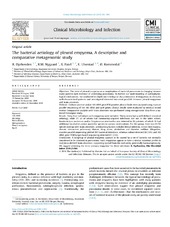| dc.description.abstract | Objectives: The view of pleural empyema as a complication of bacterial pneumonia is changing because many patients lack evidence of underlying pneumonia. To further our understanding of pathophysiological mechanisms, we conducted in-depth microbiological characterization of empyemas in clinically well-characterized patients and investigated observed microbial parallels between pleural empyemas and brain abscesses.
Methods: Culture-positive and/or 16S rRNA gene PCR-positive pleural fluids were analysed using massive parallel sequencing of the 16S rRNA and rpoB genes. Clinical details were evaluated by medical record review. Comparative analysis with brain abscesses was performed using metagenomic data from a national Norwegian study.
Results: Sixty-four individuals with empyema were included. Thirty-seven had a well-defined microbial aetiology, while 27, all of whom had community-acquired infections, did not. In the latter subset, Fusobacterium nucleatum and/or Streptococcus intermedius was detected in 26 patients, of which 18 had additional facultative and/or anaerobic species in various combinations. For this group, there was 65.5% species overlap with brain abscesses; predisposing factors included dental infection, minor chest trauma, chronic obstructive pulmonary disease, drug abuse, alcoholism and diabetes mellitus. Altogether, massive parallel sequencing yielded 385 bacterial detections, whereas culture detected 38 (10%) and 16S rRNA gene PCR/Sanger-based sequencing detected 87 (23%).
Conclusions: A subgroup of pleural empyema appears to be caused by a set of bacteria not normally considered to be involved in pneumonia. Such empyemas appear to have a similar microbial profile to oral/sinus-derived brain abscesses, supporting spread from the oral cavity, potentially haematogenously. We suggest reserving the term ‘primary empyema’ for these infections. | en_US |

